World Cup 2014 final features "most tested" football ever
Players in tonight's World Cup final in Brazil will battle for possession of the Brazuca, the official tournament ball. Adidas global football innovation director Antonio Zea told us how robot legs, shooting machines and wind tunnels were employed to make this "the most tested match ball ever" (+ interview).
Following criticisms of the Jabulani ball used at the last World Cup, testing of the Brazuca "took more than 2.5 years and yielded our most tested match ball ever," Zea told Dezeen, describing one of the trials the ball endured: "FIFA requires we test for 2000 cycles in our ball shooter machine. The test fires the ball at a wall that is covered with studs."
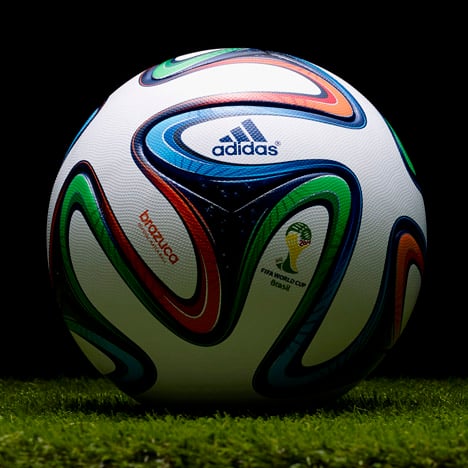
The Brazuca features the smallest number of panels used to create any ball in the history of the tournament, with six identical propeller-shaped pieces of flexible plastic that are thermally bonded to create the ball's synthetic outer skin.
"This specific panel shape and use of only six panels creates a symmetrical, uniform and homogenous design," said Zea. "The panels also provide improved grip, touch, and aerodynamics."
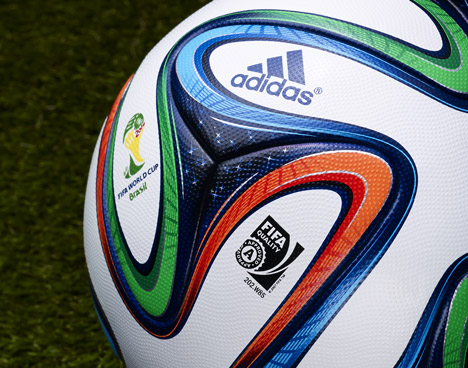
The size of the seams and the bonding methods used to assemble the pieces play a large part in the way the ball handles, with longer joins on fewer panels creating a more uniform shape and a more predictable performance.
Small pimples run across the exterior in a uniform pattern to improve the grip of the ball. This irregular surface is also intended to improve the ball's aerodynamic performance, helping to reduce drag while the ball is in flight.
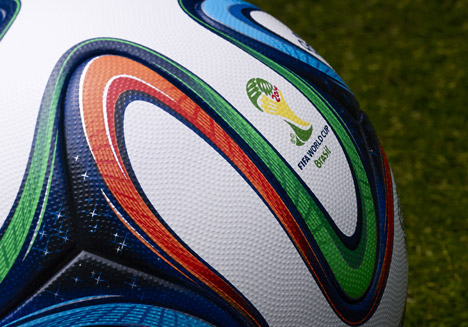
Each ball consists of a number of layers. The patterned outer surface protects a sheet of foam that encases an air-filled bladder. The bladder and carcass of the Brazuca are based on the components from balls produced for recent UEFA tournaments.
Adidas has been producing the official World Cup football since 1970, when it premiered a ball modelled on Buckminster Fuller's geodesic dome designs. The iconic Telstar football for that year's World Cup in Mexico was a hand stitched leather ball made from 20 white hexagons and 12 black pentagons.
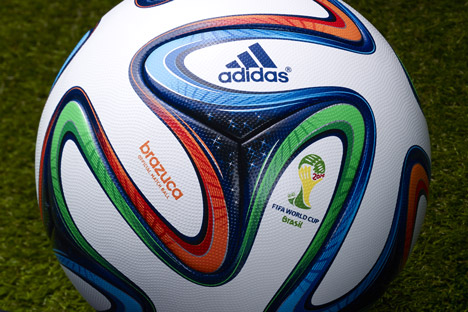
Iterations of this design were used in subsequent tournaments. The first fully synthetic ball, the Azteca, appeared in 1986. In 2006 the 32 panels were reduced to 14 for the Teamgeist, with curved pieces and bonded seams replacing the geometric shapes and stitching of previous balls.
For the 2010 World Cup in South Africa, Adidas attempted to innovate further by 3D moulding each panel on a sphere to create the eight panel Jabulani. The resulting product proved to be extremely unpopular with players, who complained that it was too light and moved unpredictably.
The coach of the England 2010 team, Fabio Capello, told the BBC that the Jabulani was the worst tournament ball he had seen. "For the players it is terrible," said Capello. "It is also terrible for the keepers because it is impossible to anticipate the trajectory."
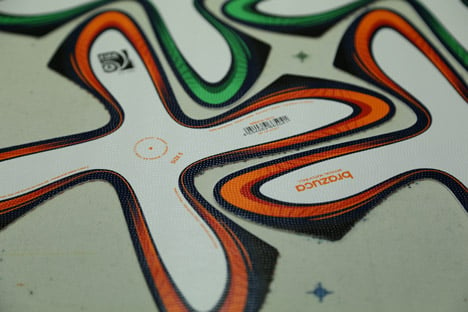
In response to this, Adidas undertook a significantly longer period of product testing for the Brazuca. The ball has been in development since 2009, with two and a half years dedicated to performance testing in Adidas' development lab and with players.
"To create a ball that players would love we took the best technology in currently successful balls like the Tango 12 [designed for the UEFA Euro 2010 tournament] and the UEFA Champions League ball and combined it with an innovative six panel design," Zea explained.
FIFA-approved balls designs must weigh between 420 and 445 grams, but player feedback suggested that a heavier ball was favoured by most players so Adidas designed a ball that would sit near the top end of the FIFA guideline weight.
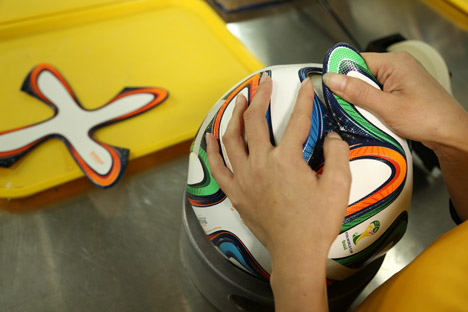
The design went through four different testing stages, starting with the official FIFA criteria.
However, in the end, "it only matters what the players say," Zea said. "What do players feel when they kick the ball? That is where most of the energy, time and resources are invested. Put the ball out on the field and let the players judge."
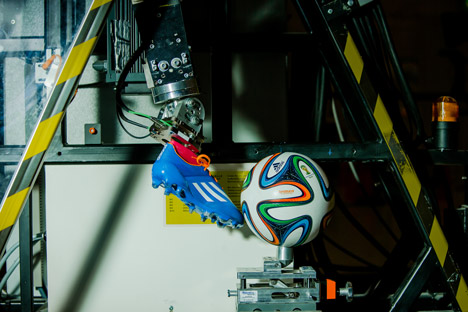
The ball is not the only Adidas design that will appear in tonight's final. Although this year marked the first time that rival sports brand Nike has kitted out more individual teams than the official tournament sponsors – commissioning bespoke typefaces from graphic designers Neville Brody and Wim Crouwel for the England and Dutch kits – both Germany and Argentina have Adidas kits.
A number of key players, including Argentina's Lionel Messi and Germany's Thomas Müller, will also be wearing boots from Adidas' Battlepack collection created for the 2014 World Cup.
Below is the transcript of the interview:
Anna Winston: Tell us about the design process.
Antonio Zea: We wanted to create a ball that players would love, as well as echo Brazil’s passion for the game, through the design. The process started in late 2009 with the desire for simplicity; the goal was to create a single-panel shape for 2014.
With the goal determined we then started to work through panel shapes to figure out how we could get one interlocking shape that would supply the performance we needed. From there we employed our founder Adi Dassler’s mantra of Listen, Test, Modify. We worked through many prototypes, panel shapes, and physical samples.
This testing took more than 2.5 years and yielded our most tested match ball ever. We worked with athletes throughout the process and tested in countries, climates, and conditions throughout the world, particularly Brazil, making sure we covered its diverse seasons, climate and altitude conditions.
Anna Winston: How did you test the ball?
Antonio Zea: We focus on four main testing territories and start with the official FIFA criteria. The great thing about a football is it is one of the few sporting goods in the world that actually has official criteria that it has to fulfill. Which is great because it makes sure that all balls that are used on the top level of the game do fulfill the highest standards. Once we pass those official criteria, we go further and check the theoretical behavior of the ball in the air. We do that by putting the ball in a wind tunnel.
The wind tunnel is great because it delivers objective values. But it also has its limitations because it mainly delivers a theoretical perspective on the performance. Therefore, we test in our own state-of-the-art lab facilities where we can do tests that reflect the performance of the ball on the field but deliver objective and reproducible results. These dynamic lab tests check three different performance criteria, speed, accuracy, and flight path. The tests are conducted with our robotic kick leg that ensures complete repeatability.
But we knew that in the end, it only matters what the players say. All of these lab tests give us a great indication and a high level of confidence that the ball is performing. But the main focus then is on player perception. What do players feel when they kick the ball? That is where most of the energy, time and resources are invested. Put the ball out on the field and let the players judge.
Anna Winston: Tell us about the design of the Brazuca.
Antonio Zea: In creating a ball for an event like the FIFA World Cup, it is important that we reflect the culture of the host nation. Therefore, we encapsulated the essence of Brazil and their passion for the game in the design through three main aspects. Firstly, the vibrant colors on the ball reflect those of the Brazilian flag as well as the official logo of the FIFA World Cup. Next we looked at the colorful wish bands that the locals wear and this is brought to life through the rhythmic and fluid use of the colors on the ball. Finally, we also incorporated stars into the design and again this harkens back to the national flag but also reflects their status as World Cup winners.
Anna Winston: How did it get its name?
Antonio Zea: The ball was named back in September 2012 following a public vote in Brazil. One million football fans got involved and the name “Brazuca” came out on top. The actual word “brazuca” is an informal local term which means “Brazilian”, or to describe the Brazilian way of life.
Anna Winston: What kind of technology has gone into the new ball
Antonio Zea: To create a ball that players would love we took the best technology in currently successful balls like the Tango 12 at EURO 2010 and the UEFA Champions League ball and combined it with an innovative 6–panel design. The 6-panels are perfectly interlocking and made of a single panel shape
The Adidas-designed ball for the last World Cup had a very mixed response. Did that affect the approach to designing the 2014 ball? Is it true that the Jabulani was too round and too light?
Antonio Zea: We are proud of the Jabulani, which at the time was our most advanced and tested ball ever. Brazuca is a brand new design and we tested it more than ever before. As with all of our balls, the weight of Brazuca meets FIFA standards. Using our vast experience in ball design, we know the most popular balls with players, including the UEFA Champions League ball, are towards the higher end of the FIFA weight range. FIFA balls must be between 420 and 445g, and during testing Brazuca averaged about 437g.
Anna Winston: How is this ball an improvement on the Jabulani?
Antonio Zea: Brazuca is the most tested ball adidas has ever created. It’s groundbreaking and innovative 6-panel design results in a ball that is accurate and has a stable flight. Brazuca has received incredible feedback from players during over 2.5 years of testing in the creation process. We worked with over 600 players in 30 professional and national teams in 10 countries. Balls were used in both training and match situations particularly the 2013 U-20 World Cup and friendlies like Argentina vs. Sweden as well as Israel vs. Finland.
Anna Winston: How does the smaller number of panels on the ball affect its performance?
Antonio Zea: This specific panel shape and use of only 6 panels creates a symmetrical, uniform and homogenous design. The 6 identical panels also provide improved grip, touch, and aerodynamics.
Anna Winston: Are there any specific examples in this year's World Cup where the design of the ball has made a difference?
Antonio Zea: We designed the ball to the highest specifications of the game and also to allow the world’s best players to be able to do what they do best, handle the ball. Whether that is dazzling dribbling, precise passing, or pinpoint free-kicks, the ball does what the players want it to do and that has been the ultimate testament to it’s success.
Anna Winston: What have you learned from this World Cup that will inform the next design?
Antonio Zea: We are currently gathering and analyzing data from this World Cup to implement in future development cycles. Player feedback is extremely important to us and we are currently in the process of thinking about future match balls.
Anna Winston: Do you design the balls to respond to the climate of the host country?
Antonio Zea: We also conduct extensive tests for durability. One in particular is a FIFA standard test, and one where we push the standard higher. For the durability tests, FIFA requires we test for 2000 cycles in our ball shooter machine. This test replicates the high stresses put on a ball when it is kicked repeatedly at high speeds. The test fires the ball at a wall that is covered with studs, which are the same as those on a football boot. We actually test to 3500 cycles and still achieve perfect results.
We design and test the ball’s work in many climates and conditions; we particularly tested Brazuca in Rio, where conditions were warmer, and São Paulo, where it was cooler, in June and July to replicate the conditions during the tournament. Temperatures ranged from the mid-30s to as low as 5°, which is as cool as it gets in Brazil at that time of year.
In our European testing, the temperatures were even more extreme, ranging from -15° to 35°. The ball was also tested at altitude – at 1300m in São Paulo and 1600m in Colorado in the United States. Moreover, it was tested on dry, slightly damp and very wet pitches, and in windy conditions, gusts and heavy rain. Brazuca performed extremely well in all these tests – making it the perfect ball for all conditions. We’ve also enlisted the expert opinions of clubs including Fluminense and Palmeiras. Everyone gave us extremely positive feedback.
Anna Winston: Do all the design elements of the ball have a big impact on the players?
Antonio Zea: Players are quite sensitive to the products they use and any changes within the ball do make a difference; from the outer layer material, to the foam, construction, panel shape and even the texture on the surface that is used to give grip in all conditions. We consider every element and also test extensively to understand players’ needs, desires, and take their feedback into account.